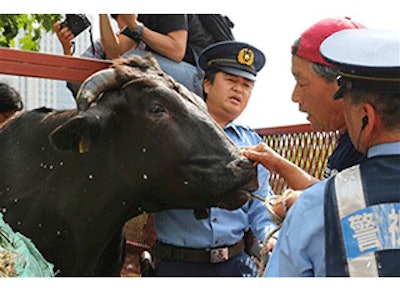
 |
| Japanese farmer Masami Yoshizawa, second right, with a black bull with speckles is surrounded by police officers blocking him from leading the bull off a truck he drove from Fukushima, northeastern Japan, in front of the Agriculture Ministry in Tokyo Friday, June 20, 2014. Yoshizawa and fellow farmer Naoto Matsumura whose livelihoods were wrecked by the March 2011 nuclear disaster at the Fukushima Dai-Ichi nuclear plant have staged a protest briefly at the ministry to appeal for help with the livestock, some of which have developed unexplained white spots on their hides. (AP Photo/Koji Sasahara) |
TOKYO (Kyodo) — A Japanese government official involved in measures to combat the toxic water buildup at the crippled Fukushima Daiichi nuclear power plant emphasized the importance of improving working conditions for the roughly 6,000 workers at the site during a recent tour for Kyodo News reporters.
"I sincerely felt the hardships workers have experienced as what's going on here is different from ordinary construction work in terms of the severe heat due to protective suits and high radiation level," said Masato Kino, the Natural Resources and Energy Agency director for management of the contaminated water at the Fukushima Daiichi plant, on Friday.
The buildup of radioactive water is a major headache for Tokyo Electric Power Co. and the government in the process of decommissioning all six reactors at the complex. Contaminated water is increasing around 400 tons per day as groundwater flows into the Nos. 1 to 4 reactor buildings.
A group of Kyodo News reporters were permitted to visit key working areas to tackle the radioactive water at the plant, accompanied by Kino and some TEPCO officials.
The agency has been providing support to TEPCO as Prime Minister Shinzo Abe has pledged active government involvement in addressing the buildup of toxic water at the nuclear plant hit by massive tsunami following the March 2011 earthquake.
"Hurry up, the dose of radiation here is high," said a TEPCO official, urging reporters to finish quickly at a spot for an underground ice wall near the No. 1 reactor, one of the three reactors that suffered meltdowns, and return to a microbus.
TEPCO began constructing the huge underground ice wall at the beginning of this month around four reactor buildings in an attempt to prevent groundwater from seeping into the buildings and mixing with heavily contaminated water.
Under the unprecedented government-funded project, 1,550 pipes will be inserted deep into the ground for 1.5 kilometers to circulate coolant and freeze the nearby soil. TEPCO aims to finish the construction and start the operation by March 2015.
However, the construction work is taking place in conditions of high radiation. "A worker is permitted to continue to do his job for about three hours a day due to legal radiation limits," said Kino.
"Look at that crane! Three out of only six or seven of that supergiant kind existing in Japan are operating here," Kino said, adding, "Current work is dominated by construction."
In addition to the huge cranes, various kinds of heavy machinery and trucks were seen on the premises as if it were a large-scale construction site.
All the people on the site, including reporters, were wearing white protective suits and full face masks. A signboard read, "Highly contaminated water here."
Using a so-called groundwater bypass system, TEPCO has since May dumped into the Pacific Ocean thousands of tons of groundwater collected from wells dug near the reactor buildings, after confirming its radiation level met safety guidelines.
The system is designed to pump out groundwater without approaching the heavily contaminated area of the complex site.
By repeating the pumping and dumping, the utility is aiming to slow the pace of highly radioactive water accumulating at the plant. "We will not be sure whether this measure is working effectively until one or two months have passed," said Kino.
An Advanced Liquid Processing System, or ALPS, has been developed to reduce the radiation level of the highly contaminated water accumulating at the plant.
ALPS is said to be capable of removing 62 different types of radioactive substances from the contaminated water, but not tritium.
The system has been plagued with trouble and is still in the trial operation stage, with all of the three lines resuming Sunday for the first time in about three months.
With the outlook unclear for the countermeasures to contain contaminated water, "This year is a crucial period. We have to do everything we can," said Kino.
"The number of workers on the site has increased to roughly 6,000, double from one year earlier. It is projected to peak out at 7,000 within one or two years," said Kenichiro Matsui, a TEPCO official in charge of public relations.
"Providing infrastructure including facilities to take rest and equipment such as dosimeters has been falling behind, although countermeasures were taken," Matsui added.
TEPCO has been building a large-scale rest house and center to provide food for workers and other facilities.
"There will be no problem in securing enough workers for the time being, but I am not sure what will happen 10, 20 or 30 years later. Improving working conditions is what is really necessary," said Kino.



















